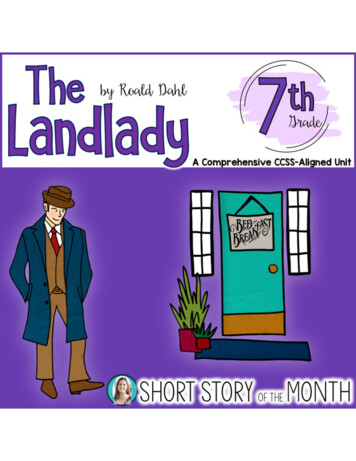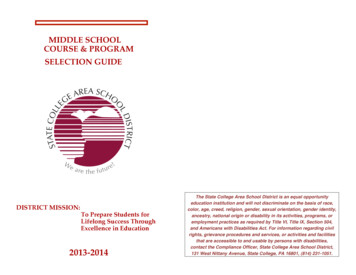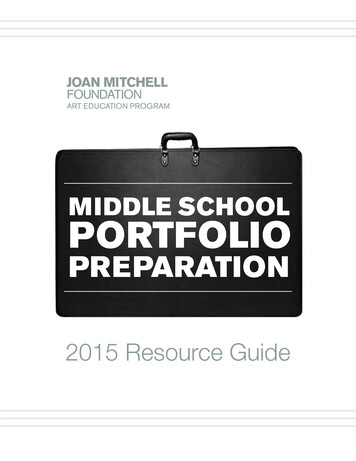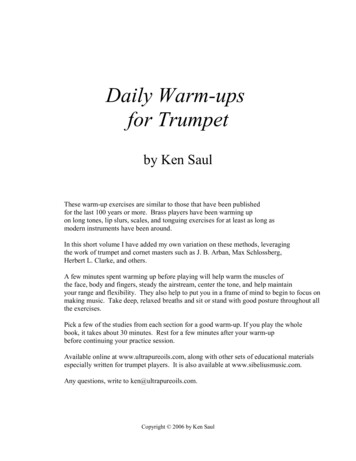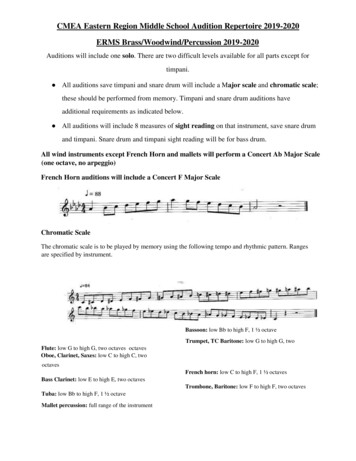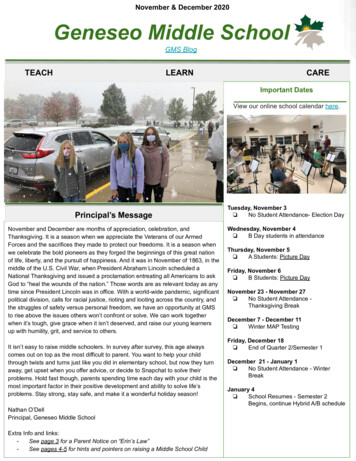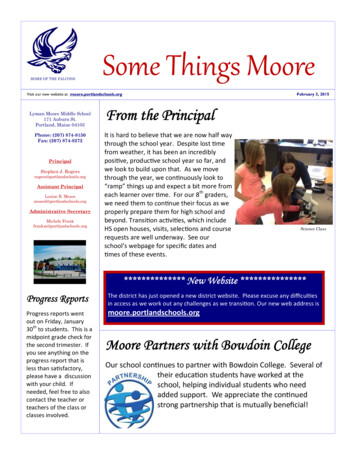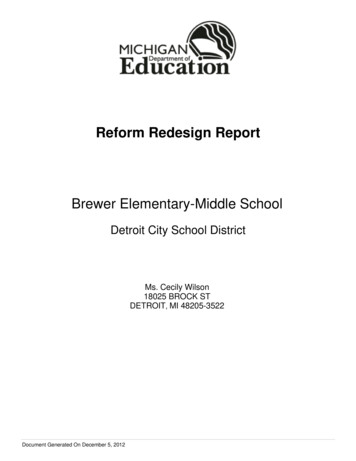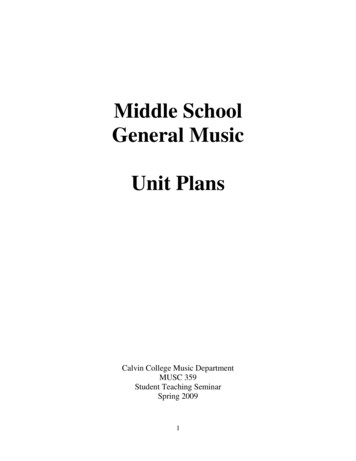
Transcription
Middle SchoolGeneral MusicUnit PlansCalvin College Music DepartmentMUSC 359Student Teaching SeminarSpring 20091
Table of ContentsThe MbiraAlyssa Loufman3OperaAlyssa Loufman18Exploring Rhythm &Culture throughPercussionAngela Gould36Music in AfricaAnna Kruger57Music in the MoviesAnna Kruger75Music Theory & NotationSarah Looman90Blues & JazzWill Karsten110The OcarinaPhillip Hash1232
Middle School General MusicUnit Plan OverviewName: Alyssa LoufmanUnit Topic/Title: MbiraDetailed Unit Description:1. After studying African music for five days, students will focus specifically on the Africaninstrument the mbira (and the modern form called the kalimba). First they will read anarticle and watch videos of music produced on the mbira. Then each student will makehis/her own mbira using the design found at http://dennishavlena.com/bobbypin.htm.They will tune the instruments as close to a G Major scale as possible. They will have achance to determine by ear simple well-known melodies. The students will learn certainmelodies by rote from the teacher. Then they will invent a system of notation that can beused when playing the mbira and compose and perform music using this system ofnotation.List Unit Objectives:2. Students will gain an understanding of the uses of the mbira in various settings,especially in the religious practices of Zimbabwe3. Students will be able to identify the sound of the African instrument the mbira4. Students will learn how to make an mbira according tohttp://dennishavlena.com/bobbypin.htm and understand its acoustical properties5. Students will learn how to play simple melodies on their home-made mbiras6. Students will invent a system of notation that can be used when playing the mbira7. Students will compose music on the mbiraMaterials List and Budget (if any):Item(s)Qnty. CostSource/VendorComputers on which students can watch these videos:25Computer Providedhttp://www.youtube.com/watch?v tIPORpN27CY&NR 1labhttp://www.youtube.com/watch?v FmCt8aGrwJc&feature relatedprovidedElectric drill13FreeBorrow frommaintenance
Large bobby pins225About 8Walgreens3/16" or 1/4" solid or plywood, 4" by 6"25Lumber yard3/8" square by 4" long hardwood25About 40About 51/4" square by 4" long hardwood25About 5Lumber yard3/4" woodscrews125About 3Bottle of wood glue2About 5HardwarestoreHardwarestoreLumber yardJustification. (What is the value of this Unit. How does it connect to students’ lives? Whyteach it?):This unit follows up on the African music unit which helps students explore the use of music in adifferent culture and geographical location than their own. The students can learn more aboutAfrican music and how it sounds as well as its roles in society (specifically in the spiritual life ofpeople in Zimbabwe). They can further develop their understanding of the personal, emotional,and spiritual power of music and how this plays into the use of music throughout the world.They also have the chance to build something they can be proud of and to explore the propertiesof musical sound as they form and tune the instruments. Many components essential to acomplete music education are included in this unit including playing music by ear, learningmusic by rote, notating music, and composing music.4
Middle School General MusicUnit OutlineName: Alyssa LoufmanUnit Topic/Title: Mbira UnitDay1.Objectives for the DayMbira1. Students will gain anunderstanding of the uses of thembira in various settings,especially in the religiouspractices of Zimbabwe2. Students will be able to identifythe sound of the Africaninstrument the mbiraLearning Activities toMeet ObjectivesStudents will work in thecomputer lab. They willeach read the NationalGeographic article andwatch the two YouTubevideos. Then they willanswer questions on theMbira worksheet.Michigan State LearningStandards Incorporatedinto LessonMiddle SchoolContent Standard 3:All students will analyze,describe and evaluate worksof art.2. Analyze the uses of elementsof music in aural examplesrepresenting diverse genres andcultures.Content Standard 4: Allstudents will understand,analyze, and describe thearts in their historical, social,and cultural contexts.1. Describe distinguishingcharacteristics ofrepresentative music5MaterialsNeededComputersAssignments &AssessmentsReading thearticle, watchingthe videos,answering thequestions on theworksheet
genres and styles froma variety of cultures.3. Compare, in severalcultures of the world,functions music serves,roles of musicians, andconditions under whichmusic is typically performed.2.3.3. Students will learn how tomake an mbira according tohttp://dennishavlena.com/bobbypin.htm and understandits acoustical properties3. Students will learn how tomake an mbira according tohttp://dennishavlena.com/bobbypin.htm and understand itsacoustical properties4. Students will learn how toplay simple melodies whenThe teacher will give eachstudent the directions formaking mbiras. The teacherwill explain why this designallows for an authenticsounding instrument and theclass will discuss theacoustical properties of thematerials being used. Thestudents will work onmaking their mbiras andhelp one another if needed.The teacher will use anelectric drill for the screws.Students will finish upmaking their mbiras. Whenstudents are finished makingthe instrument and tuning itto a G major scale, they willbe able to play theinstruments on their own.6Content Standard 5: Allstudents will recognize,analyze, and describeconnections among thearts; between the artsand other disciplines;between the arts andeveryday life.Bobby pins,wood, screws,wood glueFollowing thedirections formaking the mbiraBobby pins,wood, screws,wood glueFinishing thembira, tuning thembira properly2. Describe ways in which theprinciples and subject matterof other disciplines are relatedto music.Content Standard 5: Allstudents will recognize,analyze, and describeconnections among thearts; between the artsand other disciplines;between the arts andeveryday life.
given only the notes in amajor scaleThey will be asked to try toplay well-known melodies.2. Describe ways in which theprinciples and subject matterof other disciplines are relatedto music.Content Standard 1: Allstudents will apply skillsand knowledge to perform inthe arts.7. Play simple melodies andharmonic accompanimentsby ear.4.5.4. Students will learn how toplay simple melodies whengiven only the notes in amajor scale5. Students will invent a systemof notation that can be usedwhen playing the mbira6. Students will compose musicStudents will have sometime to play theirinstruments individually.Then the teacher will teachthe class several simplemelodies by rote. Theteacher will explain that thismethod of teaching is called“rote” teaching and thatmbira music is traditionallylearned by rote. Thenstudents will work in pairsplaying melodies andaccompaniments taught bythe teacher.The students will completetheir final assignment. Theywill work in pairs. Eachpair will come up with a7MbiraPlaying themelodies correctlyMbiraAssessment ofeach student byteacher (seerubric)Content Standard 1: Allstudents will apply skillsand knowledge to perform inthe arts.1. Sing and play withexpression and technicalaccuracy a repertoire of vocaland instrumental literature,including some songsperformed from memory.Content Standard 2: Allstudents will apply skillsand knowledge to create in
on the mbiranotation system for mbiramusic. Then each pair willcompose a short piece ofmusic (between 15 and 30seconds long). Lastly, thepairs will perform theircomposition in unison infront of the class.the arts.4. Compose short pieceswithin specified guidelines.Content Standard 1: Allstudents will apply skillsand knowledge to perform inthe arts.5. Perform accurately, withappropriate technique, on atleast one instrument —solo,in small and large ensembles.8
Mbira Unit MaterialsMbiraFrom http://worldmusic.nationalgeographic.comMbira Overview:The peaceful, lulling, polyrhythmic cycles of the Shona mbira music of Zimbabwe have becomea world-music staple. The standard mbira dzavadzimu consists of 22 iron prongs tightly clampedto a hard slab of mubvaropa wood, which acts as a soundboard. These metal keys are arranged inthree banks, what mbira master Ephat Mujuru called the voice of the children, the voice of theadults and the voice of the elders. Although the metal keys were originally smelted directly fromrock containing iron ore, these days they are often made from recycled sofa springs, bicyclespokes, car seat springs and other materials.There are several types of mbira, but the most popular is the mbira dzavadzimu, meaningliterally "mbira of the ancestor spirits," a reference to the instrument's traditional use andfunction in religious ceremonies. Some traditional musicians object to this name because theysay that all mbiras belong to the spirits. Similarly, many object to the description of theinstrument as a "thumb piano" because this term describes an African instrument only by makingreference to a European one and because mbira players use not only their thumbs but also theirright forefinger and sometimes others. But by now, both mbira and thumb piano are so widelydisseminated that they're pretty much inescapable, however problematic.The international rise of mbira began to gather steam after the 1976 publication of Paul Berliner'slandmark book The Soul of Mbira (University of Chicago Press), although it's worth pointing outthat 10 years earlier a stage show called Wait a Minim played at the John Golden Theatre inLondon, featuring mbira music arranged and directed by Andrew Tracey, son of the legendarySouth African field recordist Hugh Tracey. These were early events in a steady process ofdiscovery of Shona music around the world. Indeed the instrument is now studied and played byso many musicians, in the United States and Europe particularly, that there may already be morembira players outside Zimbabwe than within it.That said, mbira is and will always remain first and foremost Zimbabwean music, both in itstraditional, religious manifestations and in its ever growing repertoire of pop adaptations.Through recordings and international tours by mbira artists such as Stella Chiweshe, ForwardKwenda, the late Dumisani Maraire and Ephat Mujuru, Beauler Dyoko and Cosmos Magaya theinstrument and the music continue to reach new audiences all the time.Zimbabwe's mbiras—such as mbira dzavadzimu, njari, matepe and the smaller karimba—arepart of a larger family of African lamellophones that includes the Congolese likembe and sanza,the Tanzanian ilimba, the kalimba and a variety of other variants. But it is important todifferentiate these instruments. The Shona mbira dzavadzimu in particular has both musical andceremonial aspects that are quite unique. To confuse all African lamellophones under the genericterm mbira, as many do, is similar to lumping together banjos, lutes, mandolins, and all varietiesof guitar under a single heading. A lot gets lost in the mix.9
The mbira is usually played inside a large, empty calabash called a deze, which acts to amplifythe sound. A stick is used to wedge the mbira securely inside the gourd. The mbira is typicallyplayed with the two thumbs stroking down and the right forefinger stroking up. A wire strungwith bottle caps is generally strung over the lower portion of the soundboard, and bottle caps—atone time, shells—are often strung around the edges of the gourd, producing an intense buzzingsound. Adding a wake-up element to the soothing, bell-like tones of the mbira, the buzzing isconsidered to be an essential part of the music. Some modern recordings of mbira eliminate thebuzzing in order to feature the pure tones of the iron prongs. This, too, is controversial.There are many different mbira tunings, chosen according to personal preference. Thenyamaropa and gandanga tunings are probably the most common, although there are lots ofvariations, including the same relative tuning set at different pitch levels. Most mbira groupssettle on a particular tuning and use it consistently, although some newer groups, notably MbiraDzenharira, are experimenting with combining differently tuned mbiras. A composition playedon differently tuned mbiras is considered to be the same piece as long as the keys are played inthe same sequence. Traditionally, a piece is played on two or three instruments using the sametuning.For centuries, mbira music's main function was not entertainment but rather a way to contact thespirit world in all-night bira ceremonies. The songs and sound of mbira attracted the ancestorspirits, who provided advice and council by way of a spirit medium. The traditional repertoire ofceremonial mbira music consists of hundreds of pieces, some of which are thought to be morethan 700 years old. Each piece in the repertoire is appropriate to particular types of spiritceremonies. In ceremonies honoring a family ancestor, favorite pieces of the ancestor beingcalled may be played. Ceremonies honoring deceased chiefs or warrior ceremonies may requireolder, more traditional pieces. Ceremonies for the powerful guardian and nature spirits would bethe most ancient and traditional pieces. In this manner, pieces are played over and over again andpassed from generation to generation.Mbira players are often said to be hearing the sound of mbira constantly, even while sleeping.Many players talk about hearing a piece in a dream and then waking up able to play it. As such,mbira pieces are considered to be pre-existent, emanating from the spirit world, not so muchcomposed as recovered.An mbira ceremony is called a bira, and it can take many forms. Used properly, the Shonabelieve that mbira music can bring rain or sun, chase away harmful spirits and cure illnesses.Mbira music has a profound role in death ceremonies. A bira is played for a week following thedeath of a chief, even before the community is informed of his passing. Approximately one yearafter a person's physical death another ceremony is performed and the individual's spirit iswelcomed back into the community to take its place among the ancestors.There are also secular biras, such as those performed at weddings, the inaugurations of newchiefs and government events such as Independence Day and international conferences. Thembira also accompanies a large repertoire of traditional and modern children's songs andallegorical fables.10
A Shona mbira piece usually consists of a basic cyclical pattern that includes numerousintertwined melodies, often with contrasting and syncopated rhythms. Within these patterns,there are extensive possibilities for rhythmic and melodic variation. Each performance of anmbira piece is a little like a great jazz rendition of a standard composition. The identity of thepiece may be clear and the individual musician's typical style is evident, but each time theperformance is fresh, new and totally expressive of the present moment.Each piece in the traditional repertoire includes a leading part (kushaura) and an intertwiningpart (kutsinhira). Because mbira players are considered to be hearing the sound of the mbiracontinuously, when the kushaura musician begins to play there is no fixed point in the cycle to beconsidered as the "beginning." The player is merely joining in with the music already beingheard. In the same spirit, the secondary player will enter the piece at whatever point he wishes.The interlocking mbira parts result in a compact yet overflowing richness of polyphony andpolyrhythms.Mbira music is especially noteworthy for its marriage of 4/4 and 3 4 time. Most pieces can bethought of as a sequence of four 12-beat phrases. Those 12 beats can be divided into three groupsof four, or four groups of three. Often, the music is not clearly one time signature or the other butrather a beautifully ambiguous combination of the two.Once the players have established the piece and the tempo, the hosho shakers join in, creating aconsistent rhythm and completing the mbira ensemble. Occasionally, ngoma hand drums alsoparticipate. In mbira music, these drums are not used so much as a rhythmic foundation, but asconversation and commentary. However, as a piece progresses the ngoma may increasingly driveand guide the piece rhythmically.Rarely, a virtuoso mbira player will perform a ceremony alone. This requires an extremelycomplex solo style that must leave both musician and listeners satisfied that both kushaura andkutsinhira are present. This type of solo style is very specific to the individual musician.Traditional mbira pieces were probably first played on guitars and other modern instruments aslong ago as the 1950s, although the first recorded examples come from the late 1960s. Thispractice became far more common following the success of Thomas Mapfumo, who begansinging in Shona and using traditional mbira songs as the basis for his pop compositions in about1972. When combined with political messages offering encouragement to the guerilla fightersseeking to liberate the country from authoritarian white rule, mbira music became a powerfulforce in a fast-changing pop culture.Mapfumo's chimurenga music, named for the freedom fighters, threw the door wide open, andsince Zimbabwe's 1979 independence many pop groups have incorporated mbira music and eventhe instrument itself—often amplified—into their sounds. As Mapfumo's music has evolved, hehas encouraged his mbira players to branch into all kinds of nontraditional music. In this way,the instrument and the genre are growing and advancing all the time.– Banning Eyre, Courtesy Afropop Worldwide: www.afropop.org with material adapted fromwriting by Erica Azim11
Worksheet: The Mbira1. How many prongs are on the standard mbira dzavadzimu? How are they arranged?2. What is the literal translation of mbira dzavadzimu?3. From what country did mbira music originate?4. What finger(s) is/are used to play the mbira?5. What is the name of the larger family of instruments to which the mbira belongs?6. What is used to amplify the sound of the mbira?7. What role do mbiras play in all-night bira ceremonies?8. Describe a typical Shona mbira piece of music.9. In the second video (of the two men playing mbiras) what is making the buzzing soundson the mbira with a deze around it?10. Based on the sound of the music from these videos, how is mbira music similar toAmerican pop music?12
Worksheet: The Mbira1. How many prongs are on the standard mbira dzavadzimu? How are they arranged?There are 22 prongs; They are arranged in 3 banks.2. What is the literal translation of mbira dzavadzimu?Mbira dzavadzimu literally means "mbira of the ancestor spirits".3. From what country did mbira music originate?It originated from Zimbabwe.4. What finger(s) is/are used to play the mbira?The thumbs, the right forefinger, and sometimes other fingers are used.5. What is the name of the larger family of instruments to which the mbira belongs?They belong to the lamellophone family.6. What is used to amplify the sound of the mbira?An empty gourd called a deze is used to amplify the mbira.7. What role do mbiras play in all-night bira ceremonies?The mbira attracted the ancestor spirits, who provided advice and council by wayof a spirit medium. Mbira music can bring rain or sun, chase away harmful spirits andcure illnesses.8. Describe a typical Shona mbira piece of music.A Shona mbira piece consists of repeating patterns. There is not just one melody, butseveral melodies that use complex rhythms. A piece of music is usually performeddifferently each time it is played. Each piece includes a leading part and an intertwiningpart.9. In the second video (of the two men playing mbiras) what is making the buzzing soundson the mbira with a deze around it?There are bottle caps or some other round object taped around the outside of the deze.10. Based on the sound of the music from these videos, how is mbira music similar toAmerican pop music?The mbira music in the second video has an instrumental introduction before the voicescome in just like in American pop music. Also, the phrases and the words are repeated inmbira music like lyrics and phrases in an American pop song. The music has a steadybeat that someone could dance to just like many pop songs.13
A Kalimba Using Bobby-Pins as Twangers.This extremely simple kalimba is a real instrument --playability is great. Tone and volume is surprisingly good too.I made it to see just how simple a kalimba can be made.It's construction needs little or no description -- everythingcan be seen in the photo.I made this kalimba to have the same scale as a bagpipe(9 notes). There is no sound-box, only a "sound-board".The type bobby-pin used is one size bigger than "regular"bobby-pins --- they are about 2-5/8" long & a small bit widerthan 1/16". I used Goody brand, product number 01457.- Bend each bobby-pin to right angles (careful - they can break).- With each of the pins, cut off all but a half inch of the sidewith the bend. (I dulled the jagged ends with a grinder)- The soundboard is a piece of 3/16" or 1/4" solid or plywood,4" by 6". Absolutely nothing here is critical.- I used a piece of 3/8" square by 4" long hardwood that thetwangers rest on. This piece is glued to the soundboard.14
- For the piece of wood that pushes down on the twangers, I usedhardwood - 1/4" square by 4" long. Five evenly spaced 3/4"woodscrews securely clamp the twangers between these twopieces of hardwood (three screws didn't hold it good enough).Make sure that the front edges of the two hardwood pieces areflush.- The only awkward thing is holding and positioning the ninetwangers while tightening the five screws. My advice is tonot tighten the screws too tight at first --- once thetwangers are positioned properly, then tighten them.I also found it a help to clamp the instrument in a visewhile installing and tuning the twangers.- Tuning is easy, but may require a slight temporaryuntightening of the screws.Do not remove the plastic tips of the bobby-pins as they makecomfortable twanger ends.It took me a bit less than a half-hour, start to finish, tobuild.I made a simple box for an experiment, but it didn't add muchvolume, so went back to just a single board.My first bobby-pin kalimba had the twanger base mounted alongthe narrow edge of the soundboard, but the tone of the shortertwangers was not good. By instead mounting the twanger basealong the wider edge of the soundboard (and about 3/8" in fromthe edge), the tone improved immensely.This is a good tuning:ti so mi do * re fa la do' * a full step below "do" 15
The short length of the bobby-pins more or less limits what keythe instrument can be tuned in -- Optimum sound/tone in my case(where the lowest note uses almost the full length of thebobby-pin) was when the instrument was tuned in the key of G butconsidering that this simple kalimba will likely never be playedin a band, the key is relatively unimportant.Fun little thing!I made another such instrument, but used regular sized (smaller)bobby-pins instead. it worked fine too --- had a different, butalso pleasant tone.Dennis Havlena - W8MIMackinac Straits, northern Michigan10/14/200116
Mbira Unit Final AssignmentRubricThe student has invented a notation system that is useable on the mbira./10The student composed functional music for the mbira between fifteen and thirtyseconds long./10The student performed using proper playing techniques on the mbira./10The student demonstrated his/her understanding of the specific instrument./5The student demonstrated general knowledge of music (based on themusical information that has been presented thus far in the class)./5Total/4017
Middle School General MusicUnit Plan OverviewName: Alyssa LoufmanUnit Topic/Title: OperaDetailed Unit Description:The unit will begin with a class discussion about students’ knowledge and views of opera. Thenstudents will watch and listen to three YouTube videos. One video is the scene from Puccini’sLa Boheme in which Musetta sings "Quando me'n vò". The second video is from Offenbach’sTales of Hoffman in which the “Barcarolle” duet is performed. The third video is fromGershwin’s Porgy and Bess and includes the well-known “Summertime”. There will be a classdiscussion after watching the videos. Then students will break up into groups to createpresentations based on this website: .html.Next the class will watch the opera “Where the Wild Things Are” by Maurice Sendak. Then theunit will end with a final class discussion about opera.List Unit Objectives:1.2.3.4.Students will evaluate their own knowledge of opera and their opinions of operaStudents will listen to operatic music and analyze it’s distinct qualitiesStudents will become familiar with the history of operaStudents will actively discuss opera’s role in society and opera’s perception by variouspeople groups5. Students will recognize typical aspects of opera in “Where the Wild Things Are”6. Students will analyze the effectiveness of the acting and singing in opera performances asit relates to the story-line of the opera7. Students will analyze the effectiveness of the use of various musical features in telling thestoryMaterials List and Budget (if any):Item(s)VHS or DVD of “Where the WildThings Are”Poster boardQnty.1Cost 50Source/VendorAmazon.com3About 3WalgreensMarkers12BorrowBorrow from art departmentfrom artdepartment18
Justification. (What is the value of this Unit. How does it connect to students’ lives? Whyteach it?):This unit will allow students to reflect on their perception of opera and the perceptions otherpeople have of opera. If their views of opera were negative initially they are given the chance toreconsider what opera means in society and how they can develop a more positive view of opera.In this class the students and teacher will discuss how opera relates to musical theater and howopera incorporates all aspects of drama and all aspects of music in one medium. Students willview opera in the light of contemporary acting and singing. They will also explore how opera isrelated to other forms of entertainment such as sporting events, television, and concerts.Students will be exposed to a contemporary form of opera from a children’s book that many ofthe students will be familiar with.19
Middle School General MusicUnit OutlineName: Alyssa LoufmanUnit Topic/Title: Opera Unit1.Opera8. Students will evaluate their ownknowledge of opera and theiropinions of opera9. Students will listen to operaticmusic and analyze it’s distinctqualitiesThe unit will begin with aclass discussion aboutstudents’ knowledge andviews of opera (seediscussion handout). Thenstudents will watch andlisten to three YouTubevideos. They will have thetexts and translations as theywatch these videos.http://www.youtube.com/watch?v k0V6Bq0jU4Q&feature relatedhttp://www.youtube.com/watch?v KEiZJ97O5A&feature relatedhttp://www.youtube.com/watch?v tElL6kWwmv4There will be a classdiscussion after watching20ComputersContent Standard 3:All students will analyze,describe and evaluate worksof art.2. Analyze the uses of elementsof music in aural examplesrepresenting diverse genres andcultures.Content Standard 4: Allstudents will understand,analyze, and describe thearts in their historical, social,and cultural contexts.1. Describe distinguishingcharacteristics ofrepresentative musicgenres and styles froma variety of cultures.3. Compare, in severalcultures of the world,functions music serves,roles of musicians, andconditions under whichmusic is typically performed.Watching thevideos,participation inthe classdiscussion
the videos.Content Standard 5: Allstudents will recognize,analyze, and describeconnections among thearts; between the artsand other disciplines;between the arts andeveryday life.1. Compare how thecharacteristic materials ofeach art can be used totransform similar events,scenes, emotions, or ideas intoworks of art.2. Describe ways in whichthe principles and subjectmatter of other disciplinesare related to music.2.1. Students will become familiarwith the history of opera2. Students will actively discussopera’s role in society andopera’s perception by variouspeople groupsThen students will break upinto three groups to createpresentations using postersto organize their thoughts.The presentations will bebased on these ontent/2374/2374 aida operahistory.pdfOne group will present on21Content Standard 3:All students will analyze,describe and evaluate worksof art.2. Analyze the uses of elementsof music in aural examplesrepresenting diverse genres andcultures.Content Standard 4: Allstudents will understand,analyze, and describe thearts in their historical, social,and cultural contexts.Poster board andmarkersContribution tothe group work,assessment ofeach student onpresentation (seerubric)
how opera began, another onthe development of opera,and the last group onmodern opera.1. Describe distinguishingcharacteristics ofrepresentative musicgenres and styles froma variety of cultures.3. Compare, in severalcultures of the world,functions music serves,roles of musicians, andconditions under whichmusic is typically performed.Content Standard 5: Allstudents will recognize,analyze, and describeconnections among thearts; between the artsand other disciplines;between the arts andeveryday life.1. Compare how thecharacteristic materials ofeach art can be used totransform similar events,scenes, emotions, or ideas intoworks of art.3.1. Students will recognize typicalaspects of opera in “Where theWild Things Are”Next the class will watch theopera “Where the WildThings Are” by MauriceSendak. The unit will endwith a final class discussionabout opera.22Content Standard 3:All students will analyze,describe
method of teaching is called “rote” teaching and that mbira music is traditionally learned by rote. Then students will work in pairs playing melodies and accompaniments taught by the teacher. Content Standard 1: All students will apply skills and knowledge to perform in




